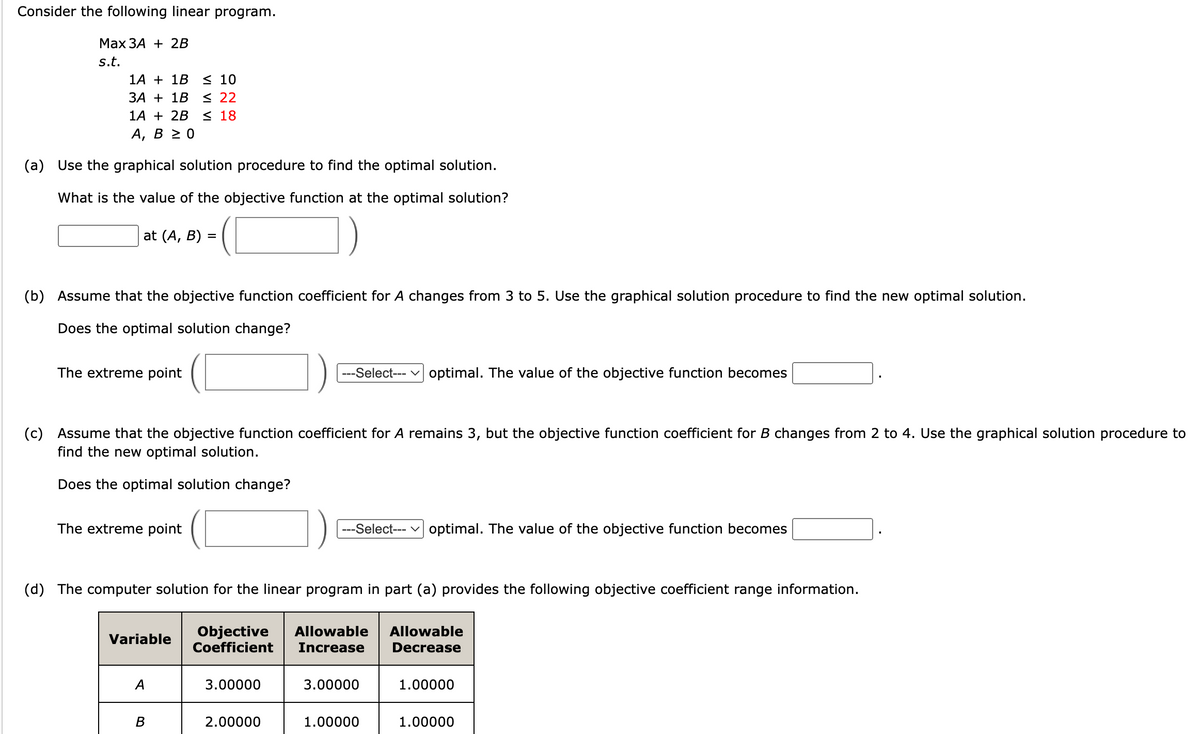(a) Use the graphical solution procedure to find the optimal solution. What is the value of the objective function at the optimal solution? at (A, B) = (b) Assume that the objective function coefficient for A changes from 3 to 5. Use the graphical solution procedure to find the new optimal solution. Does the optimal solution change? The extreme point ---Select--- optimal. The value of the objective function becomes (c) Assume that the objective function coefficient for A remains 3, but the objective function coefficient for B changes from 2 to 4. Use the graphical solution procedure to find the new optimal solution. Does the optimal solution change? The extreme point ---Select--- optimal. The value of the objective function becomes
(a) Use the graphical solution procedure to find the optimal solution. What is the value of the objective function at the optimal solution? at (A, B) = (b) Assume that the objective function coefficient for A changes from 3 to 5. Use the graphical solution procedure to find the new optimal solution. Does the optimal solution change? The extreme point ---Select--- optimal. The value of the objective function becomes (c) Assume that the objective function coefficient for A remains 3, but the objective function coefficient for B changes from 2 to 4. Use the graphical solution procedure to find the new optimal solution. Does the optimal solution change? The extreme point ---Select--- optimal. The value of the objective function becomes
Practical Management Science
6th Edition
ISBN:9781337406659
Author:WINSTON, Wayne L.
Publisher:WINSTON, Wayne L.
Chapter7: Nonlinear Optimization Models
Section: Chapter Questions
Problem 51P
Related questions
Question

Transcribed Image Text:Consider the following linear program.
Max 3A + 2B
s.t.
1A
1B ≤ 10
3A + 1B ≤ 22
1A + 2B ≤ 18
A, B ≥ 0
(a) Use the graphical solution procedure to find the optimal solution.
What is the value of the objective function at the optimal solution?
at (A, B) =
(b) Assume that the objective function coefficient for A changes from 3 to 5. Use the graphical solution procedure to find the new optimal solution.
Does the optimal solution change?
The extreme point
(c) Assume that the objective function coefficient for A remains 3, but the objective function coefficient for B changes from 2 to 4. Use the graphical solution procedure to
find the new optimal solution.
Does the optimal solution change?
The extreme point
Variable
(d) The computer solution for the linear program in part (a) provides the following objective coefficient range information.
Objective Allowable Allowable
Coefficient Increase Decrease
A
B
---Select--- optimal. The value of the objective function becomes
3.00000
2.00000
---Select--- optimal. The value of the objective function becomes
3.00000
1.00000
1.00000
1.00000

Transcribed Image Text:Use this objective coefficient range information to answer parts (b) and (c).
The objective coefficient range for variable A is
to
---Select--- change. The objective coefficient range for variable B is
optimal solution ---Select--- ✓ change.
Since the change in part (b) is ---Select--- this range, we know the optimal solution
Since the change in part (c) is ---Select--- this range, we know the
to
Expert Solution
This question has been solved!
Explore an expertly crafted, step-by-step solution for a thorough understanding of key concepts.
This is a popular solution!
Trending now
This is a popular solution!
Step by step
Solved in 5 steps with 1 images

Follow-up Questions
Read through expert solutions to related follow-up questions below.
Follow-up Question

Transcribed Image Text:(d) The computer solution for the linear program in part (a) provides the following objective coefficient range information.
Variable
A
B
Objective Allowable
Coefficient Increase
3.00000
2.00000
3.00000
1.00000
Allowable
Decrease
1.00000
1.00000
Use this objective coefficient range information to answer parts (b) and (c).
The objective coefficient range for variable A is
variable B is
to
to
Since the change in part (b) is ---Select--- this range, we know the optimal solution ---Select--- change. The objective coefficient range for
Since the change in part (c) is ---Select--- this range, we know the optimal solution ---Select--- change.
Solution
Recommended textbooks for you

Practical Management Science
Operations Management
ISBN:
9781337406659
Author:
WINSTON, Wayne L.
Publisher:
Cengage,

Practical Management Science
Operations Management
ISBN:
9781337406659
Author:
WINSTON, Wayne L.
Publisher:
Cengage,